University Essay: Leadership for Quality and Safety in Healthcare
VerifiedAdded on 2022/10/15
|7
|2049
|23
Essay
AI Summary
This essay examines the critical role of leadership in ensuring quality and safety within the healthcare sector. It explores the increasing complexity of the healthcare environment and the demand for effective health professionals. The essay delves into the significance of human factors, including environmental, organizational, and individual attributes, and their impact on work performance. It analyzes the relationship between human factors and quality/safety, emphasizing the importance of effective inter-related relationships for current and future healthcare systems. The analysis includes discussions on human error, ergonomics, and the application of models like HFE and SEIPS to improve outcomes. The essay highlights the need to understand human-system interactions and the implications of human errors, especially in high-risk scenarios. It also emphasizes the importance of adapting to the ever-changing landscape of the healthcare sector, with an ultimate goal of minimizing errors and enhancing patient safety through leadership and quality assurance.
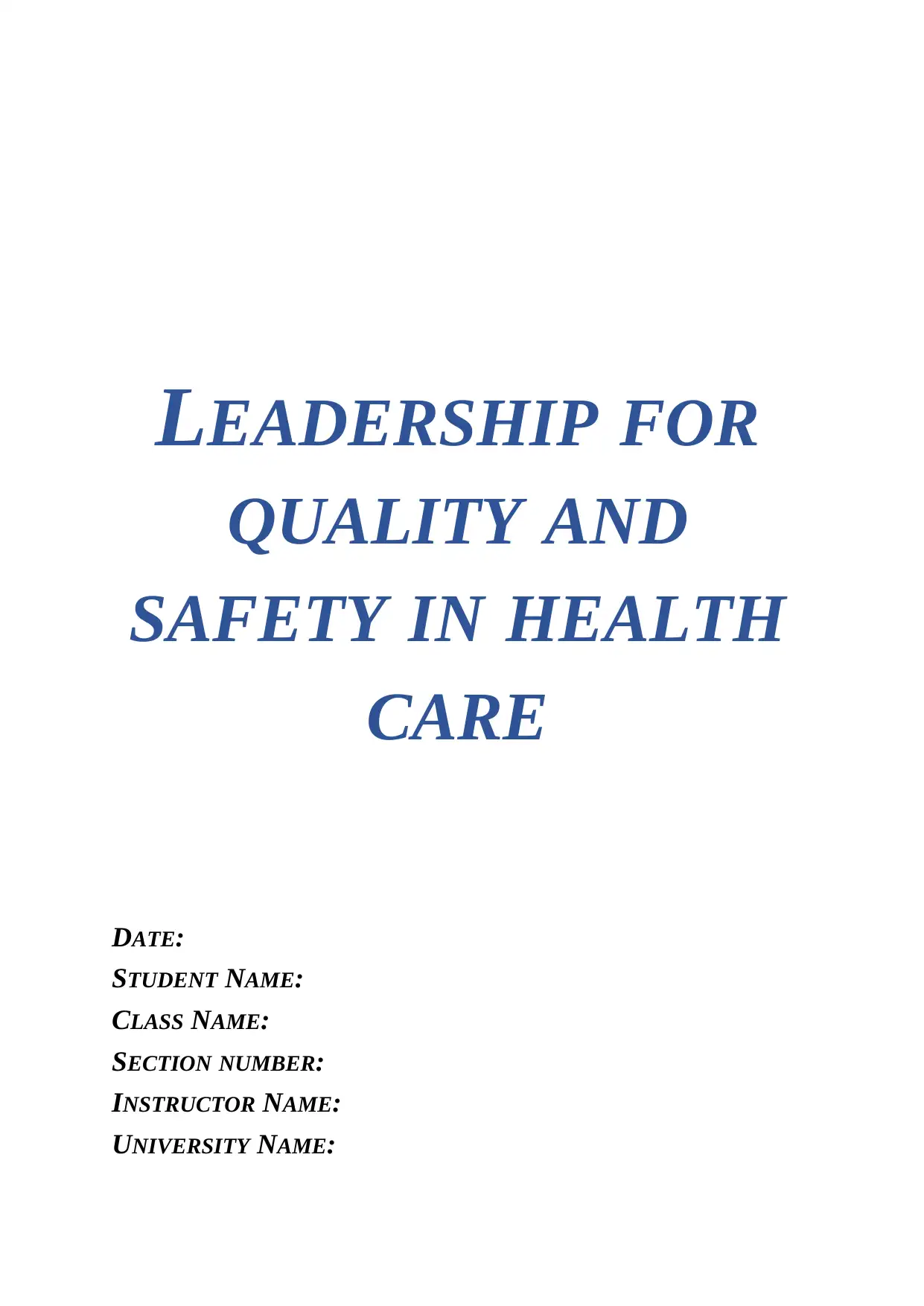
LEADERSHIP FOR
QUALITY AND
SAFETY IN HEALTH
CARE
DATE:
STUDENT NAME:
CLASS NAME:
SECTION NUMBER:
INSTRUCTOR NAME:
UNIVERSITY NAME:
QUALITY AND
SAFETY IN HEALTH
CARE
DATE:
STUDENT NAME:
CLASS NAME:
SECTION NUMBER:
INSTRUCTOR NAME:
UNIVERSITY NAME:
Paraphrase This Document
Need a fresh take? Get an instant paraphrase of this document with our AI Paraphraser
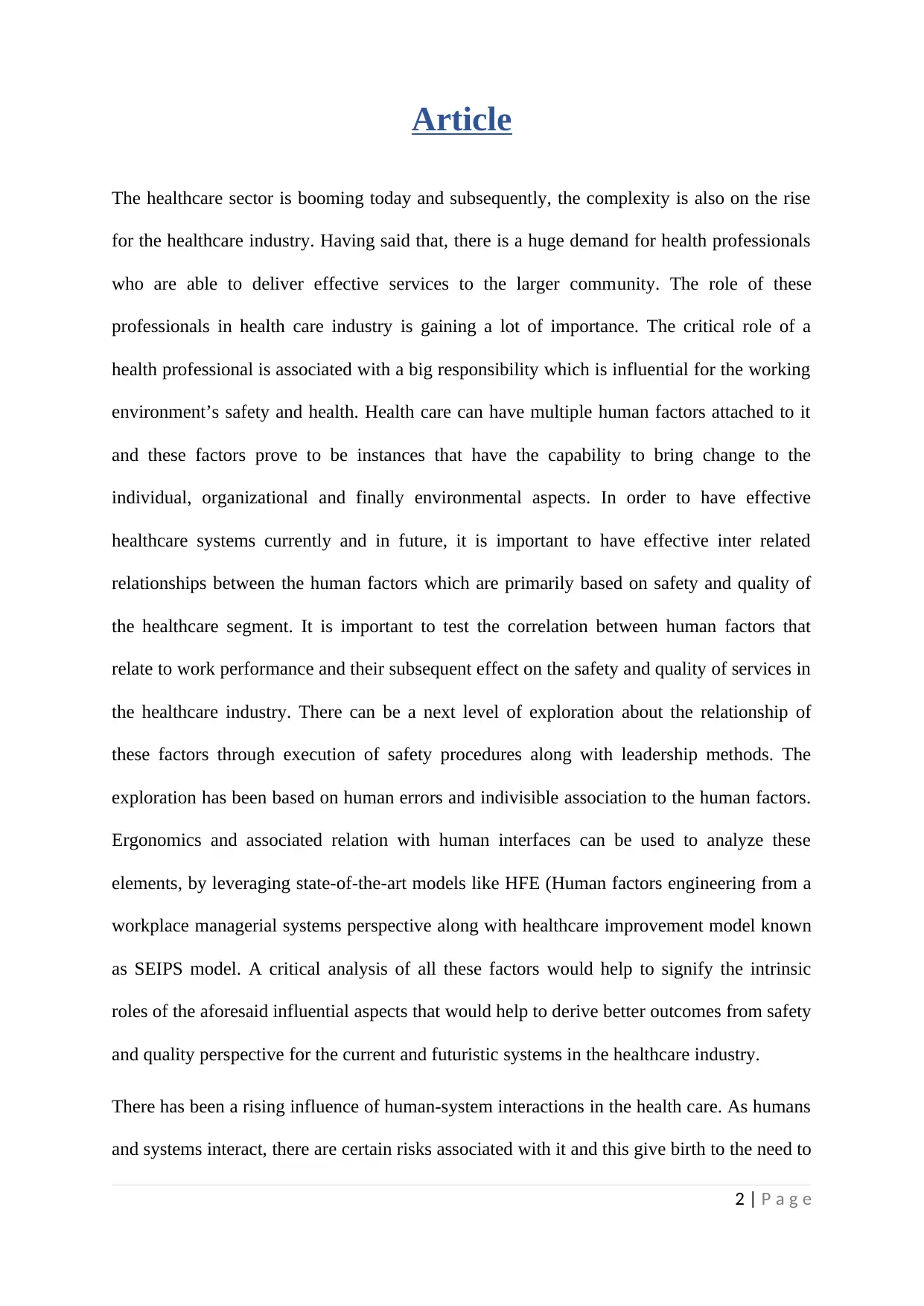
Article
The healthcare sector is booming today and subsequently, the complexity is also on the rise
for the healthcare industry. Having said that, there is a huge demand for health professionals
who are able to deliver effective services to the larger community. The role of these
professionals in health care industry is gaining a lot of importance. The critical role of a
health professional is associated with a big responsibility which is influential for the working
environment’s safety and health. Health care can have multiple human factors attached to it
and these factors prove to be instances that have the capability to bring change to the
individual, organizational and finally environmental aspects. In order to have effective
healthcare systems currently and in future, it is important to have effective inter related
relationships between the human factors which are primarily based on safety and quality of
the healthcare segment. It is important to test the correlation between human factors that
relate to work performance and their subsequent effect on the safety and quality of services in
the healthcare industry. There can be a next level of exploration about the relationship of
these factors through execution of safety procedures along with leadership methods. The
exploration has been based on human errors and indivisible association to the human factors.
Ergonomics and associated relation with human interfaces can be used to analyze these
elements, by leveraging state-of-the-art models like HFE (Human factors engineering from a
workplace managerial systems perspective along with healthcare improvement model known
as SEIPS model. A critical analysis of all these factors would help to signify the intrinsic
roles of the aforesaid influential aspects that would help to derive better outcomes from safety
and quality perspective for the current and futuristic systems in the healthcare industry.
There has been a rising influence of human-system interactions in the health care. As humans
and systems interact, there are certain risks associated with it and this give birth to the need to
2 | P a g e
The healthcare sector is booming today and subsequently, the complexity is also on the rise
for the healthcare industry. Having said that, there is a huge demand for health professionals
who are able to deliver effective services to the larger community. The role of these
professionals in health care industry is gaining a lot of importance. The critical role of a
health professional is associated with a big responsibility which is influential for the working
environment’s safety and health. Health care can have multiple human factors attached to it
and these factors prove to be instances that have the capability to bring change to the
individual, organizational and finally environmental aspects. In order to have effective
healthcare systems currently and in future, it is important to have effective inter related
relationships between the human factors which are primarily based on safety and quality of
the healthcare segment. It is important to test the correlation between human factors that
relate to work performance and their subsequent effect on the safety and quality of services in
the healthcare industry. There can be a next level of exploration about the relationship of
these factors through execution of safety procedures along with leadership methods. The
exploration has been based on human errors and indivisible association to the human factors.
Ergonomics and associated relation with human interfaces can be used to analyze these
elements, by leveraging state-of-the-art models like HFE (Human factors engineering from a
workplace managerial systems perspective along with healthcare improvement model known
as SEIPS model. A critical analysis of all these factors would help to signify the intrinsic
roles of the aforesaid influential aspects that would help to derive better outcomes from safety
and quality perspective for the current and futuristic systems in the healthcare industry.
There has been a rising influence of human-system interactions in the health care. As humans
and systems interact, there are certain risks associated with it and this give birth to the need to
2 | P a g e
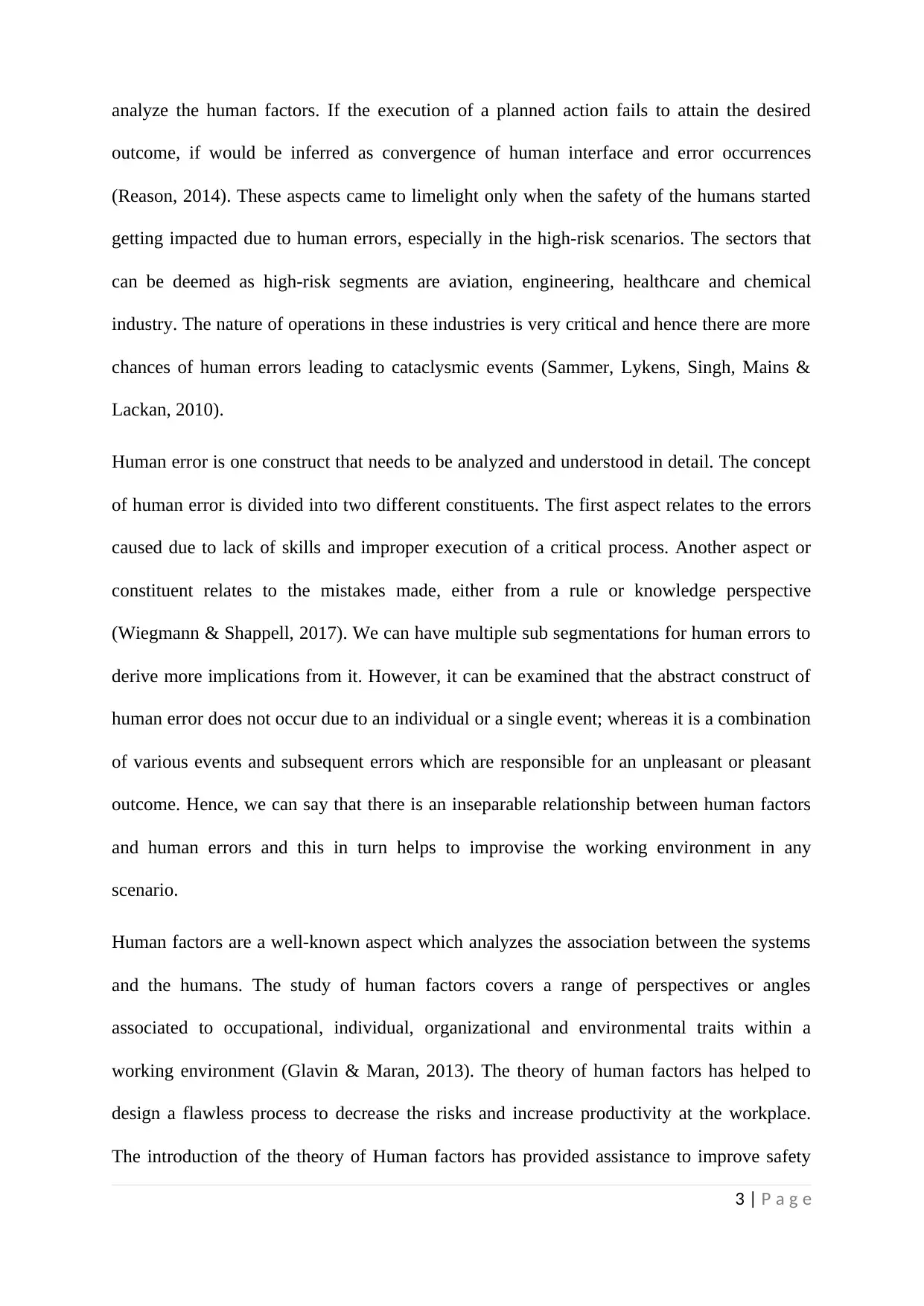
analyze the human factors. If the execution of a planned action fails to attain the desired
outcome, if would be inferred as convergence of human interface and error occurrences
(Reason, 2014). These aspects came to limelight only when the safety of the humans started
getting impacted due to human errors, especially in the high-risk scenarios. The sectors that
can be deemed as high-risk segments are aviation, engineering, healthcare and chemical
industry. The nature of operations in these industries is very critical and hence there are more
chances of human errors leading to cataclysmic events (Sammer, Lykens, Singh, Mains &
Lackan, 2010).
Human error is one construct that needs to be analyzed and understood in detail. The concept
of human error is divided into two different constituents. The first aspect relates to the errors
caused due to lack of skills and improper execution of a critical process. Another aspect or
constituent relates to the mistakes made, either from a rule or knowledge perspective
(Wiegmann & Shappell, 2017). We can have multiple sub segmentations for human errors to
derive more implications from it. However, it can be examined that the abstract construct of
human error does not occur due to an individual or a single event; whereas it is a combination
of various events and subsequent errors which are responsible for an unpleasant or pleasant
outcome. Hence, we can say that there is an inseparable relationship between human factors
and human errors and this in turn helps to improvise the working environment in any
scenario.
Human factors are a well-known aspect which analyzes the association between the systems
and the humans. The study of human factors covers a range of perspectives or angles
associated to occupational, individual, organizational and environmental traits within a
working environment (Glavin & Maran, 2013). The theory of human factors has helped to
design a flawless process to decrease the risks and increase productivity at the workplace.
The introduction of the theory of Human factors has provided assistance to improve safety
3 | P a g e
outcome, if would be inferred as convergence of human interface and error occurrences
(Reason, 2014). These aspects came to limelight only when the safety of the humans started
getting impacted due to human errors, especially in the high-risk scenarios. The sectors that
can be deemed as high-risk segments are aviation, engineering, healthcare and chemical
industry. The nature of operations in these industries is very critical and hence there are more
chances of human errors leading to cataclysmic events (Sammer, Lykens, Singh, Mains &
Lackan, 2010).
Human error is one construct that needs to be analyzed and understood in detail. The concept
of human error is divided into two different constituents. The first aspect relates to the errors
caused due to lack of skills and improper execution of a critical process. Another aspect or
constituent relates to the mistakes made, either from a rule or knowledge perspective
(Wiegmann & Shappell, 2017). We can have multiple sub segmentations for human errors to
derive more implications from it. However, it can be examined that the abstract construct of
human error does not occur due to an individual or a single event; whereas it is a combination
of various events and subsequent errors which are responsible for an unpleasant or pleasant
outcome. Hence, we can say that there is an inseparable relationship between human factors
and human errors and this in turn helps to improvise the working environment in any
scenario.
Human factors are a well-known aspect which analyzes the association between the systems
and the humans. The study of human factors covers a range of perspectives or angles
associated to occupational, individual, organizational and environmental traits within a
working environment (Glavin & Maran, 2013). The theory of human factors has helped to
design a flawless process to decrease the risks and increase productivity at the workplace.
The introduction of the theory of Human factors has provided assistance to improve safety
3 | P a g e
⊘ This is a preview!⊘
Do you want full access?
Subscribe today to unlock all pages.

Trusted by 1+ million students worldwide
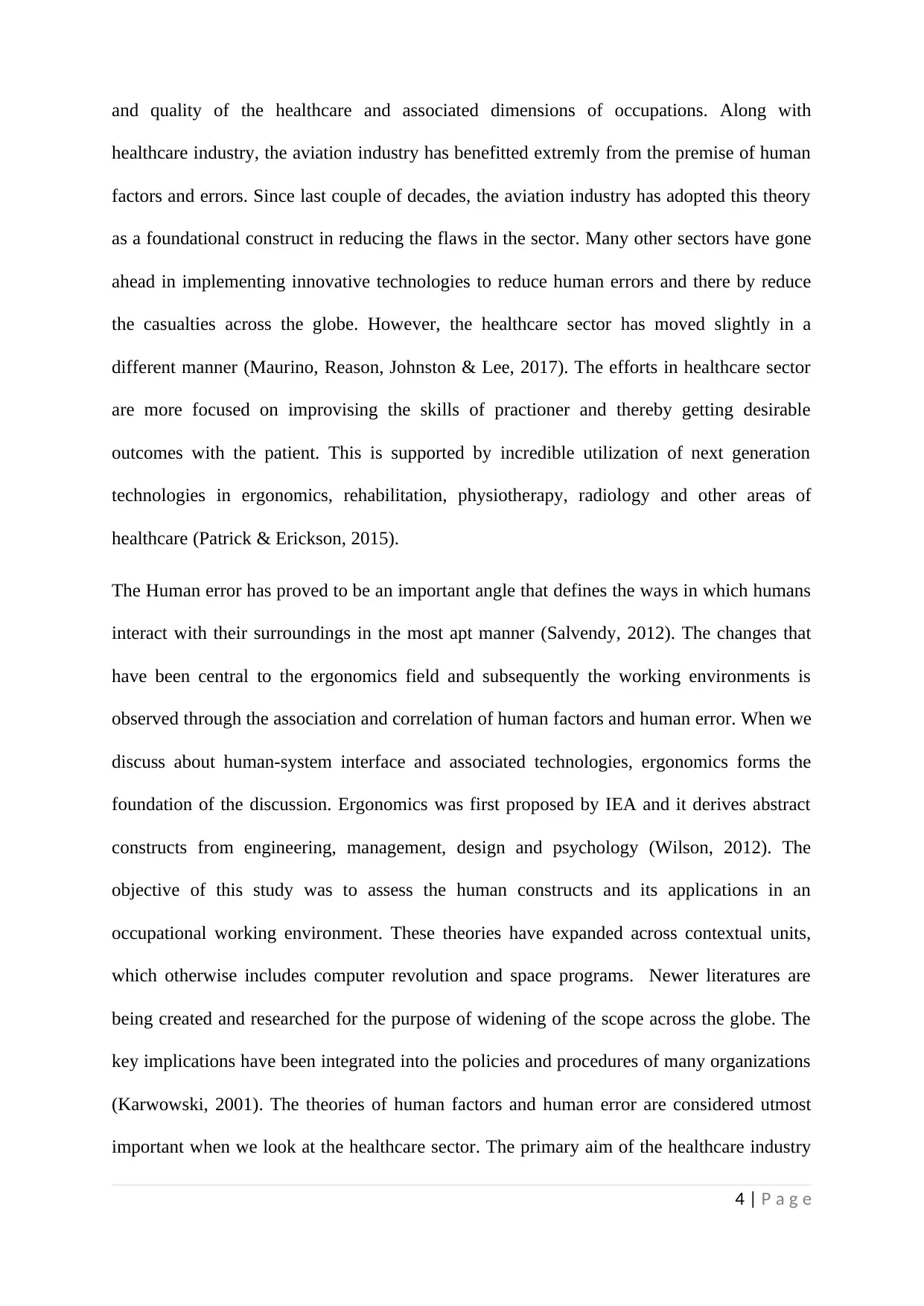
and quality of the healthcare and associated dimensions of occupations. Along with
healthcare industry, the aviation industry has benefitted extremly from the premise of human
factors and errors. Since last couple of decades, the aviation industry has adopted this theory
as a foundational construct in reducing the flaws in the sector. Many other sectors have gone
ahead in implementing innovative technologies to reduce human errors and there by reduce
the casualties across the globe. However, the healthcare sector has moved slightly in a
different manner (Maurino, Reason, Johnston & Lee, 2017). The efforts in healthcare sector
are more focused on improvising the skills of practioner and thereby getting desirable
outcomes with the patient. This is supported by incredible utilization of next generation
technologies in ergonomics, rehabilitation, physiotherapy, radiology and other areas of
healthcare (Patrick & Erickson, 2015).
The Human error has proved to be an important angle that defines the ways in which humans
interact with their surroundings in the most apt manner (Salvendy, 2012). The changes that
have been central to the ergonomics field and subsequently the working environments is
observed through the association and correlation of human factors and human error. When we
discuss about human-system interface and associated technologies, ergonomics forms the
foundation of the discussion. Ergonomics was first proposed by IEA and it derives abstract
constructs from engineering, management, design and psychology (Wilson, 2012). The
objective of this study was to assess the human constructs and its applications in an
occupational working environment. These theories have expanded across contextual units,
which otherwise includes computer revolution and space programs. Newer literatures are
being created and researched for the purpose of widening of the scope across the globe. The
key implications have been integrated into the policies and procedures of many organizations
(Karwowski, 2001). The theories of human factors and human error are considered utmost
important when we look at the healthcare sector. The primary aim of the healthcare industry
4 | P a g e
healthcare industry, the aviation industry has benefitted extremly from the premise of human
factors and errors. Since last couple of decades, the aviation industry has adopted this theory
as a foundational construct in reducing the flaws in the sector. Many other sectors have gone
ahead in implementing innovative technologies to reduce human errors and there by reduce
the casualties across the globe. However, the healthcare sector has moved slightly in a
different manner (Maurino, Reason, Johnston & Lee, 2017). The efforts in healthcare sector
are more focused on improvising the skills of practioner and thereby getting desirable
outcomes with the patient. This is supported by incredible utilization of next generation
technologies in ergonomics, rehabilitation, physiotherapy, radiology and other areas of
healthcare (Patrick & Erickson, 2015).
The Human error has proved to be an important angle that defines the ways in which humans
interact with their surroundings in the most apt manner (Salvendy, 2012). The changes that
have been central to the ergonomics field and subsequently the working environments is
observed through the association and correlation of human factors and human error. When we
discuss about human-system interface and associated technologies, ergonomics forms the
foundation of the discussion. Ergonomics was first proposed by IEA and it derives abstract
constructs from engineering, management, design and psychology (Wilson, 2012). The
objective of this study was to assess the human constructs and its applications in an
occupational working environment. These theories have expanded across contextual units,
which otherwise includes computer revolution and space programs. Newer literatures are
being created and researched for the purpose of widening of the scope across the globe. The
key implications have been integrated into the policies and procedures of many organizations
(Karwowski, 2001). The theories of human factors and human error are considered utmost
important when we look at the healthcare sector. The primary aim of the healthcare industry
4 | P a g e
Paraphrase This Document
Need a fresh take? Get an instant paraphrase of this document with our AI Paraphraser
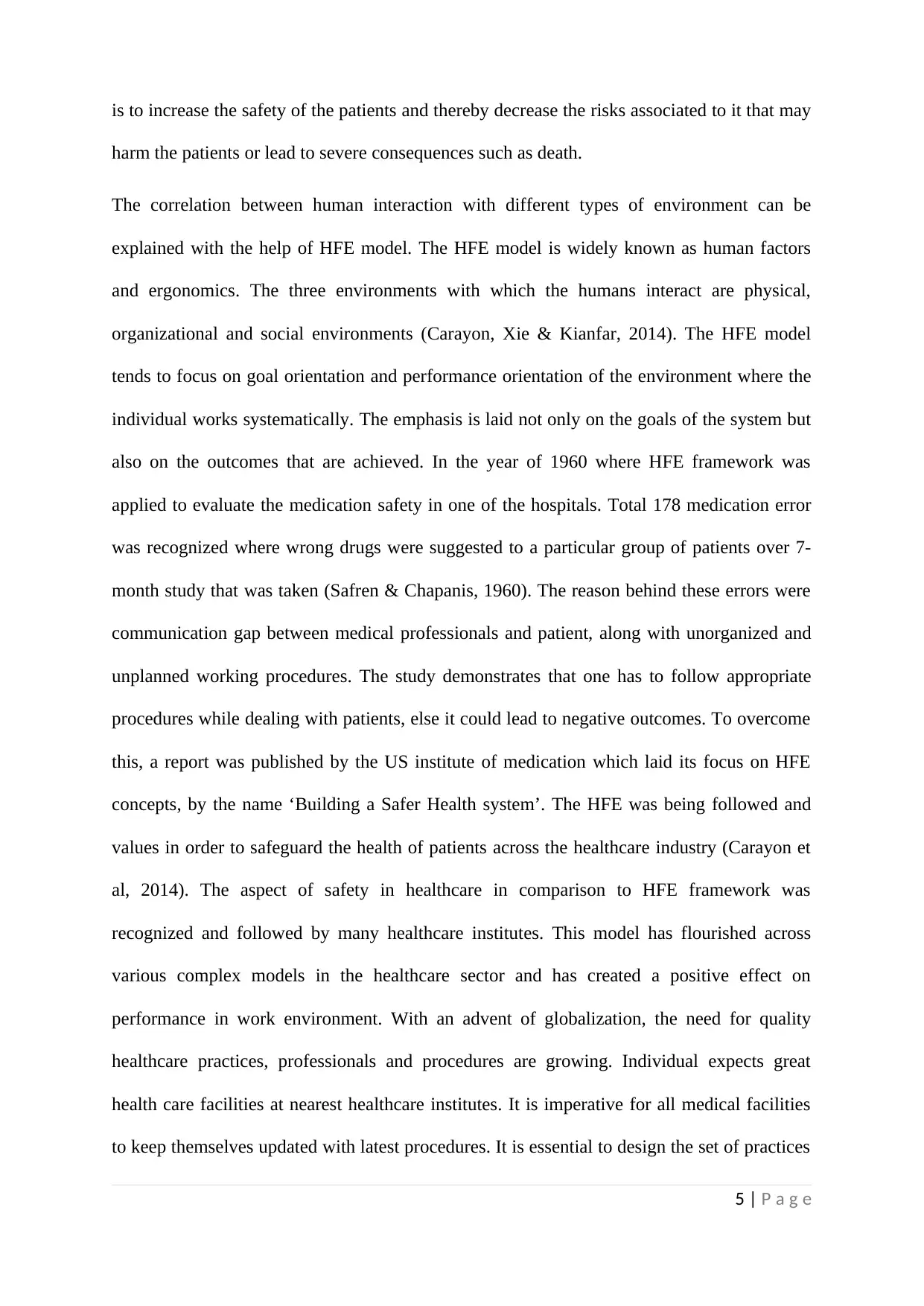
is to increase the safety of the patients and thereby decrease the risks associated to it that may
harm the patients or lead to severe consequences such as death.
The correlation between human interaction with different types of environment can be
explained with the help of HFE model. The HFE model is widely known as human factors
and ergonomics. The three environments with which the humans interact are physical,
organizational and social environments (Carayon, Xie & Kianfar, 2014). The HFE model
tends to focus on goal orientation and performance orientation of the environment where the
individual works systematically. The emphasis is laid not only on the goals of the system but
also on the outcomes that are achieved. In the year of 1960 where HFE framework was
applied to evaluate the medication safety in one of the hospitals. Total 178 medication error
was recognized where wrong drugs were suggested to a particular group of patients over 7-
month study that was taken (Safren & Chapanis, 1960). The reason behind these errors were
communication gap between medical professionals and patient, along with unorganized and
unplanned working procedures. The study demonstrates that one has to follow appropriate
procedures while dealing with patients, else it could lead to negative outcomes. To overcome
this, a report was published by the US institute of medication which laid its focus on HFE
concepts, by the name ‘Building a Safer Health system’. The HFE was being followed and
values in order to safeguard the health of patients across the healthcare industry (Carayon et
al, 2014). The aspect of safety in healthcare in comparison to HFE framework was
recognized and followed by many healthcare institutes. This model has flourished across
various complex models in the healthcare sector and has created a positive effect on
performance in work environment. With an advent of globalization, the need for quality
healthcare practices, professionals and procedures are growing. Individual expects great
health care facilities at nearest healthcare institutes. It is imperative for all medical facilities
to keep themselves updated with latest procedures. It is essential to design the set of practices
5 | P a g e
harm the patients or lead to severe consequences such as death.
The correlation between human interaction with different types of environment can be
explained with the help of HFE model. The HFE model is widely known as human factors
and ergonomics. The three environments with which the humans interact are physical,
organizational and social environments (Carayon, Xie & Kianfar, 2014). The HFE model
tends to focus on goal orientation and performance orientation of the environment where the
individual works systematically. The emphasis is laid not only on the goals of the system but
also on the outcomes that are achieved. In the year of 1960 where HFE framework was
applied to evaluate the medication safety in one of the hospitals. Total 178 medication error
was recognized where wrong drugs were suggested to a particular group of patients over 7-
month study that was taken (Safren & Chapanis, 1960). The reason behind these errors were
communication gap between medical professionals and patient, along with unorganized and
unplanned working procedures. The study demonstrates that one has to follow appropriate
procedures while dealing with patients, else it could lead to negative outcomes. To overcome
this, a report was published by the US institute of medication which laid its focus on HFE
concepts, by the name ‘Building a Safer Health system’. The HFE was being followed and
values in order to safeguard the health of patients across the healthcare industry (Carayon et
al, 2014). The aspect of safety in healthcare in comparison to HFE framework was
recognized and followed by many healthcare institutes. This model has flourished across
various complex models in the healthcare sector and has created a positive effect on
performance in work environment. With an advent of globalization, the need for quality
healthcare practices, professionals and procedures are growing. Individual expects great
health care facilities at nearest healthcare institutes. It is imperative for all medical facilities
to keep themselves updated with latest procedures. It is essential to design the set of practices
5 | P a g e
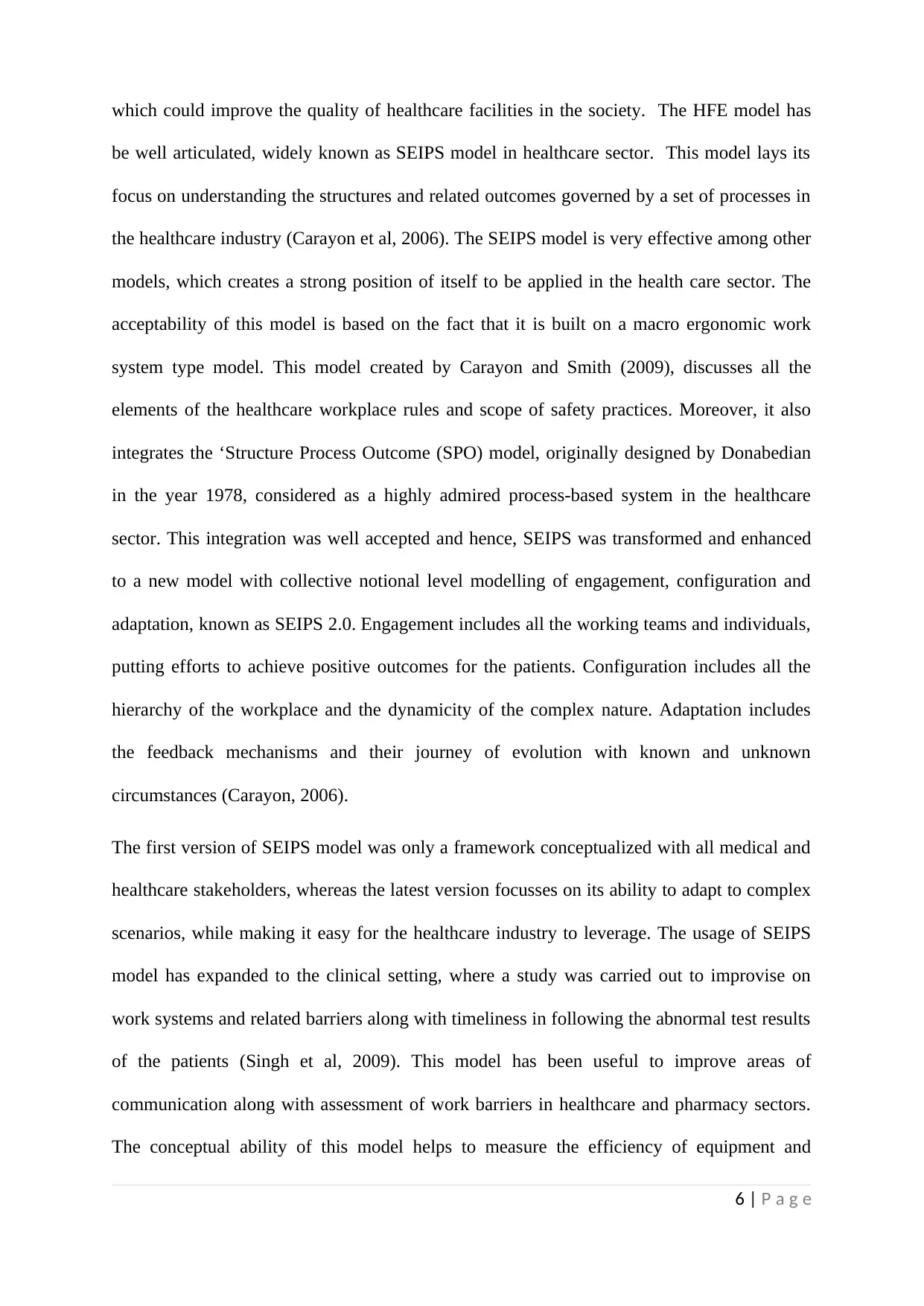
which could improve the quality of healthcare facilities in the society. The HFE model has
be well articulated, widely known as SEIPS model in healthcare sector. This model lays its
focus on understanding the structures and related outcomes governed by a set of processes in
the healthcare industry (Carayon et al, 2006). The SEIPS model is very effective among other
models, which creates a strong position of itself to be applied in the health care sector. The
acceptability of this model is based on the fact that it is built on a macro ergonomic work
system type model. This model created by Carayon and Smith (2009), discusses all the
elements of the healthcare workplace rules and scope of safety practices. Moreover, it also
integrates the ‘Structure Process Outcome (SPO) model, originally designed by Donabedian
in the year 1978, considered as a highly admired process-based system in the healthcare
sector. This integration was well accepted and hence, SEIPS was transformed and enhanced
to a new model with collective notional level modelling of engagement, configuration and
adaptation, known as SEIPS 2.0. Engagement includes all the working teams and individuals,
putting efforts to achieve positive outcomes for the patients. Configuration includes all the
hierarchy of the workplace and the dynamicity of the complex nature. Adaptation includes
the feedback mechanisms and their journey of evolution with known and unknown
circumstances (Carayon, 2006).
The first version of SEIPS model was only a framework conceptualized with all medical and
healthcare stakeholders, whereas the latest version focusses on its ability to adapt to complex
scenarios, while making it easy for the healthcare industry to leverage. The usage of SEIPS
model has expanded to the clinical setting, where a study was carried out to improvise on
work systems and related barriers along with timeliness in following the abnormal test results
of the patients (Singh et al, 2009). This model has been useful to improve areas of
communication along with assessment of work barriers in healthcare and pharmacy sectors.
The conceptual ability of this model helps to measure the efficiency of equipment and
6 | P a g e
be well articulated, widely known as SEIPS model in healthcare sector. This model lays its
focus on understanding the structures and related outcomes governed by a set of processes in
the healthcare industry (Carayon et al, 2006). The SEIPS model is very effective among other
models, which creates a strong position of itself to be applied in the health care sector. The
acceptability of this model is based on the fact that it is built on a macro ergonomic work
system type model. This model created by Carayon and Smith (2009), discusses all the
elements of the healthcare workplace rules and scope of safety practices. Moreover, it also
integrates the ‘Structure Process Outcome (SPO) model, originally designed by Donabedian
in the year 1978, considered as a highly admired process-based system in the healthcare
sector. This integration was well accepted and hence, SEIPS was transformed and enhanced
to a new model with collective notional level modelling of engagement, configuration and
adaptation, known as SEIPS 2.0. Engagement includes all the working teams and individuals,
putting efforts to achieve positive outcomes for the patients. Configuration includes all the
hierarchy of the workplace and the dynamicity of the complex nature. Adaptation includes
the feedback mechanisms and their journey of evolution with known and unknown
circumstances (Carayon, 2006).
The first version of SEIPS model was only a framework conceptualized with all medical and
healthcare stakeholders, whereas the latest version focusses on its ability to adapt to complex
scenarios, while making it easy for the healthcare industry to leverage. The usage of SEIPS
model has expanded to the clinical setting, where a study was carried out to improvise on
work systems and related barriers along with timeliness in following the abnormal test results
of the patients (Singh et al, 2009). This model has been useful to improve areas of
communication along with assessment of work barriers in healthcare and pharmacy sectors.
The conceptual ability of this model helps to measure the efficiency of equipment and
6 | P a g e
⊘ This is a preview!⊘
Do you want full access?
Subscribe today to unlock all pages.

Trusted by 1+ million students worldwide
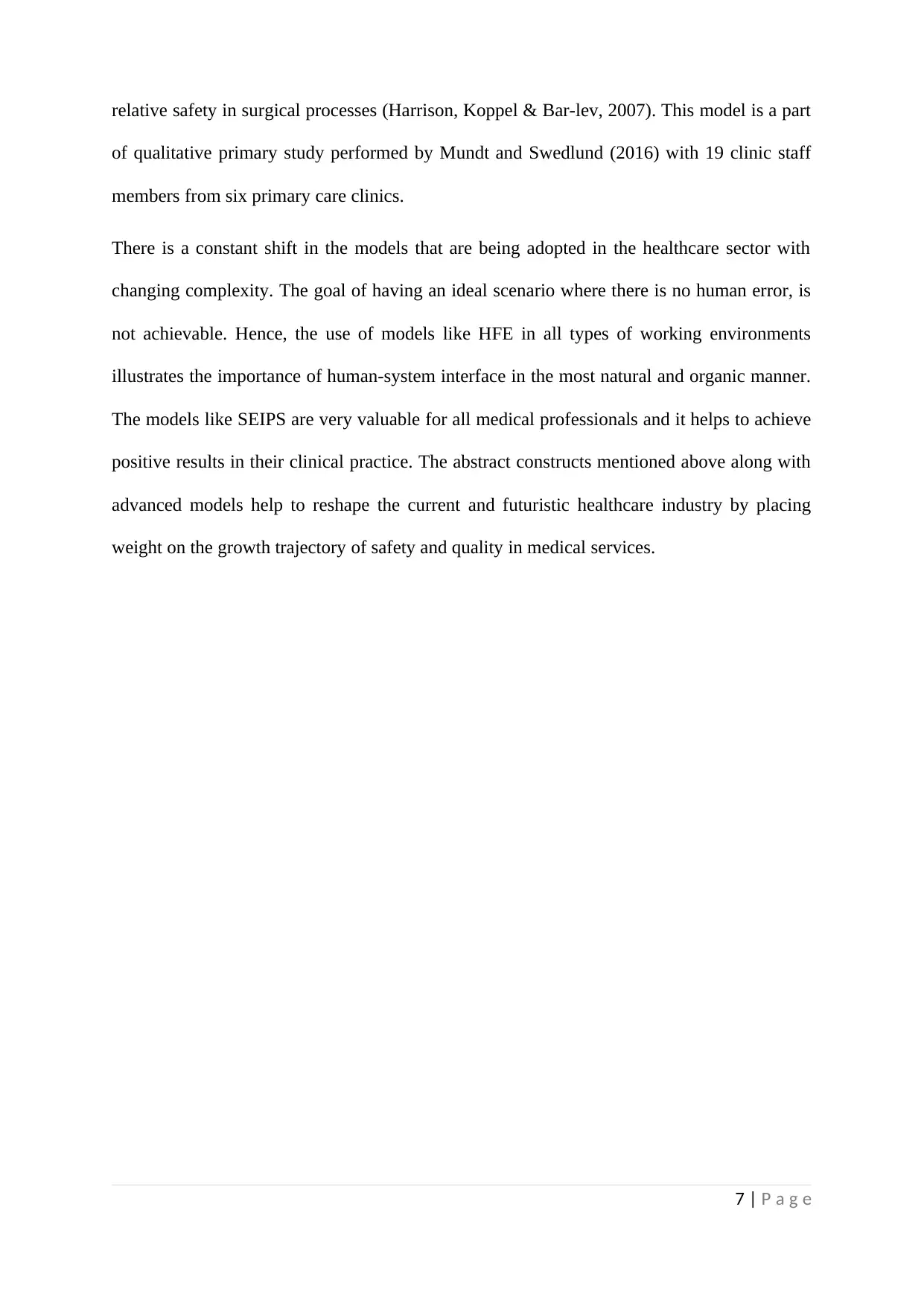
relative safety in surgical processes (Harrison, Koppel & Bar-lev, 2007). This model is a part
of qualitative primary study performed by Mundt and Swedlund (2016) with 19 clinic staff
members from six primary care clinics.
There is a constant shift in the models that are being adopted in the healthcare sector with
changing complexity. The goal of having an ideal scenario where there is no human error, is
not achievable. Hence, the use of models like HFE in all types of working environments
illustrates the importance of human-system interface in the most natural and organic manner.
The models like SEIPS are very valuable for all medical professionals and it helps to achieve
positive results in their clinical practice. The abstract constructs mentioned above along with
advanced models help to reshape the current and futuristic healthcare industry by placing
weight on the growth trajectory of safety and quality in medical services.
7 | P a g e
of qualitative primary study performed by Mundt and Swedlund (2016) with 19 clinic staff
members from six primary care clinics.
There is a constant shift in the models that are being adopted in the healthcare sector with
changing complexity. The goal of having an ideal scenario where there is no human error, is
not achievable. Hence, the use of models like HFE in all types of working environments
illustrates the importance of human-system interface in the most natural and organic manner.
The models like SEIPS are very valuable for all medical professionals and it helps to achieve
positive results in their clinical practice. The abstract constructs mentioned above along with
advanced models help to reshape the current and futuristic healthcare industry by placing
weight on the growth trajectory of safety and quality in medical services.
7 | P a g e
1 out of 7
Related Documents
Your All-in-One AI-Powered Toolkit for Academic Success.
+13062052269
info@desklib.com
Available 24*7 on WhatsApp / Email
![[object Object]](/_next/static/media/star-bottom.7253800d.svg)
Unlock your academic potential
Copyright © 2020–2025 A2Z Services. All Rights Reserved. Developed and managed by ZUCOL.




